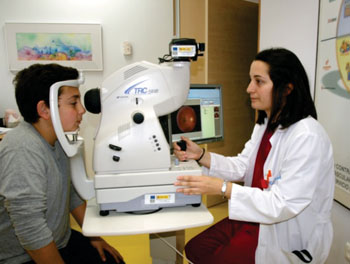Pulse Wave Diagnosis Helps Estimate Cardiovascular Risk
By HospiMedica International staff writers
Posted on 09 Apr 2014
New software helps clinicians assess future cardiovascular risk by examining the structure of the eye in children.Posted on 09 Apr 2014
Researchers at Hospital General de Valencia (Spain), Universitat Politècnica de València (Spain), and the Ophthalmology Unit of the Foundation for the Health and Biomedical Research of the Comunitat Valenciana (FISABIO-Oftalmología Médica, Valencia, Spain) have developed specialized software to make an in-depth study of the retinal microvascular architecture in children born with low birth-weight.

Image: Dr. Empar Lurbe Ferrer conducting a fundus examination (Photo courtesy of Hospital General de Valencia).
Pediatric patients undergo various noninvasive tests and all of them are interpreted together, giving as a result an approximation of what is happening in the children’s vessels. Among the tests are pulse wave morphology and speed of the blood as it travels through the vessels, and how it returns. Another test is a fundus scan with a nonmydriatic retinal camera to define the caliber and the branching angle of the retinal vessels to understand blood circulation. The measurements can indicate if a child who has a different branching angle could have an increase in blood pressure over the years.
Using the software, the researchers and pediatricians are analyzing the relationship between the various measurements and adult diseases such as hypertension or cardiovascular problems. By learning more about the retinal attributes of these pathologies as they appear in the newborn, the researchers can possibly determine characteristics that could imply a higher cardiovascular risk when the child reaches adulthood.
“Children with intrauterine growth retardation are those who are at a greater risk of developing cardiovascular diseases, such as hypertension or type 2 diabetes,” said Empar Lurbe Ferrer, MD, head of the pediatrics unit at Hospital General de Valencia. “Because of this, we are using the measurements to see if the branching angles of the vessels of children who have intrauterine growth retardation are different than those who do not.”
“This joint work between engineers and pediatricians aims to provide better care for pediatric patients,” said telecommunication engineer Sandra Morales, a researcher at the LabHuman technology center of the Universitat Politècnica de València. “Our system permits us to establish objective connections between different vessels and help clinical staff to detect these pathologies at the earliest stage. As a result they will help give more personalized treatments.”
Related Links:
Hospital General de Valencia
Universitat Politècnica de València
Foundation for the Health and Biomedical Research of the Comunitat Valenciana














